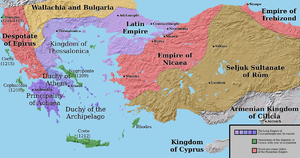Michael I Komnenos Doukas
In order to avoid invasion and buy time to consolidate his position in Epirus, Michael soon entered into negotiations with Pope Innocent III, and concluded treaties with the Latin Empire and the Republic of Venice.
The only medieval sources to use the surname "Angelos" to refer to Michael were later pro-Palaiologos historians hostile to him and the Epirote state's rival claims to the Byzantine inheritance.
[6] Michael is first mentioned on 14 February 1190, when he, along with other imperial relatives, served as a hostage to Frederick I Barbarossa (r. 1152–1190) during the passage of the Third Crusade through Byzantine territory.
[7][8] He then went on to serve as governor (doux and anagrapheus) of the theme of Mylasa and Melanoudion in Asia Minor during the last years of Isaac II's first reign.
Alexios III campaigned against him in the summer 1201 and defeated him, forcing Michael to seek refuge at the court of the Seljuk Turk Sultan of Rûm, Süleymanshah II (r. 1196–1204).
[12][14] According to Geoffrey of Villehardouin, a participant in the Fourth Crusade and author of De la Conquête de Constantinople, at the time of the fall of Constantinople to the forces of the Fourth Crusade, Michael was present in the city, having possibly returned from exile in the period after the deposition of Alexios III and the restoration of Isaac II and his son Alexios IV in 1203–04.
[15][17] Although generally regarded as inaccurate due to the many errors it contains, this part of the hagiography is at least partially corroborated by Villehardouin's account that he married the daughter of a local magnate.
[23][24] In reality, as modern research has shown, neither Michael nor his half-brother and successor, Theodore Komnenos Doukas, bore the title.
[22] In the treaty of partition of the Byzantine Empire among the Crusaders, Epirus had been allotted to Venice, but although it had occupied in 1205 Dyrrhachium, the chief port for the Albanian hinterland, and the island of Corfu in 1207, the maritime-minded Republic had shown little interest in the rest of its mainland.
Modern researchers have linked this reference either with his supposed leadership in the battle of Kountouras, or, more plausibly, with an abortive campaign in the Peloponnese sometime in 1207–09 in order to aid the beleaguered ruler of Argos and Corinth, Leo Sgouros, who was being besieged by the Crusaders in his citadel on the Acrocorinth.
Michael was able to sidestep an outright declaration of submission by offering the hand of his eldest daughter to the Emperor's brother, Eustace, and a third of his lands as her dowry.
[30][33] Finally, in early 1210, Michael's envoys, the Bishop of Tzernikon Theodore and Symeon Kounales, met with the Venetian duke of Dyrrhachium, Marino Vallaresso, and negotiated a treaty, confirmed by oath on 20 June.
[35][36] Learning of their fate, Michael offered to ransom the former imperial couple and eventually secured their release, welcoming them at Salagora, the port of Arta, where they arrived by ship.
His attempt ended in complete failure in the Battle of Antioch on the Maeander in 1211, where Theodore I Laskaris killed Kaykhusraw and took Alexios prisoner.
At the head of Latin mercenaries, he captured the constable of the Kingdom of Thessalonica and baron of Domokos, the Lombard Amé Buffa, and a hundred of his companions.
[43] It is possible that during this campaign, Henry was assisted by his vassals from Achaea, thereby explaining the reference in the Pope's correspondence of Achaean barons fighting against Michael, rather than assuming an Epirote expedition to the Peloponnese.
When d'Autremencourt seized a few islands in the Corinthian Gulf off Galaxeidi, the inhabitants of the latter called upon Michael for aid, and in the ensuing battle, Thomas was killed and Salona (modern Amfissa) was occupied.
The Epirotes took Larissa, where they deposed the Latin Archbishop and restored the local see to an Orthodox metropolitan, Velestino, the fief of Berthold of Katzenelnbogen, and reached the shores of the Pagasetic Gulf at Demetrias.
[51] Michael continued to push northward into Albania and Macedonia, taking Kruja and ending the independence of the principality of Arbanon and its ruler, Dimitri Progoni, but his attempt to seize Zeta was stopped by the Serbs at Skadar.
Theodore had been in the service of Nicaea, and Michael had requested Laskaris to send him to Epirus because his own son's position was weak.
In the event, Theodore not only sidelined the young Michael II, but according to the hagiography of St. Theodora of Arta, sent him and his mother to exile in the Peloponnese for the duration of his reign.
[53] Theodore proved a powerful and warlike ruler, greatly expanding the Epirote state and capturing Thessalonica in 1224, where he was crowned emperor.
The rise of Theodore's Empire of Thessalonica ended abruptly with his defeat and capture by the Bulgarians at the Battle of Klokotnitsa in 1230, that allowed the exiled Michael II to return to Epirus and recover his father's domain.
[54] Michael laid the foundations of the Epirote state,[1] and initiated a dynasty, the Komnenoi–Doukai, who would rule over Epirus until 1318, when the Italian Orsini family took over.
[56] The contemporary Archbishop of Ohrid Demetrios Chomatianos even estimated that at least half, if not most, of those who fled from Constantinople, found refuge in Epirus, including many of the senatorial aristocracy.




